There are not many berry bushes in our gardens that begin to delight with fruits in the early summer. Among them - the honeysuckle is an edible, unpretentious frost-resistant culture, successfully growing even in Siberia.
To obtain abundant fruiting, honeysuckle planting in the fall is desirable. Knowing the specifics of shrub agricultural technology, the secrets of care and reproduction, getting a tasty and healthy berry crop will not be difficult.
Content
- 1 Valuable properties of honeysuckle
- 2 When to plant honeysuckle: autumn or spring
- 3 Choosing a landing place
- 4 Selection of planting material
- 5 The number of honeysuckle bushes on the site
- 6 Honeysuckle planting pattern
- 7 Landing in the regions: features
- 8 Decorative honeysuckle: landing
- 9 Young planting care
- 10 Breeding
- 11 Shelter for the winter
- 12 Honeysuckle transplant to a new place
- 13 Storage of seedlings before planting in the ground
- 14 Reviews
- 15 Conclusion
Valuable properties of honeysuckle
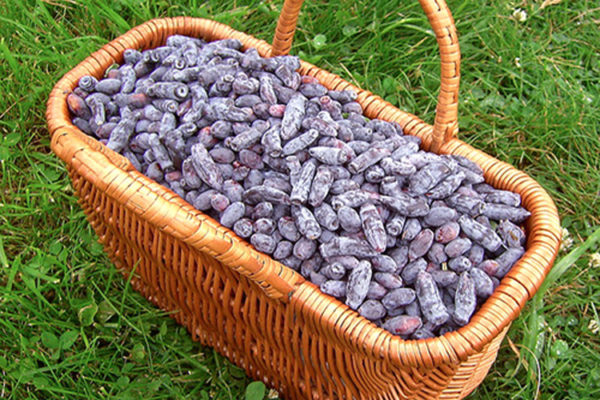 Culture is not as popular as raspberries or currants, but in recent years the situation has changed. And if earlier honeysuckle was mainly grown for decorative purposes, today many varieties have been developed that produce delicious blue berries.
Culture is not as popular as raspberries or currants, but in recent years the situation has changed. And if earlier honeysuckle was mainly grown for decorative purposes, today many varieties have been developed that produce delicious blue berries.
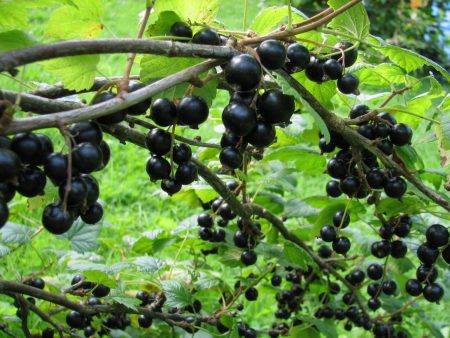 You may be interested in:
You may be interested in:They are valued for their high content of vitamins C, A, B1, B2, B9, tannins, and pectins. As part of the acid berries:
- apple
- oxalic;
- amber;
- lemon.
Honeysuckle is used for stomach diseases, rheumatism, eczema, as an antipyretic and vaso-strengthening agent. Berries and juice have an antiviral, choleretic, antioxidant effect.
Among the varieties are considered fruitful:
- Souvenir;
- Masha;
- Nymph.
Derived honeysuckle with berries, the taste of which is similar to strawberries:
- Titmouse;
- Roxane
- Cinderella;
- Kamchadalka.
During flowering in the spring, the bushes are covered with beautiful white-pink, blue flowers. Therefore, honeysuckle is often used in landscape design.
When to plant honeysuckle: autumn or spring
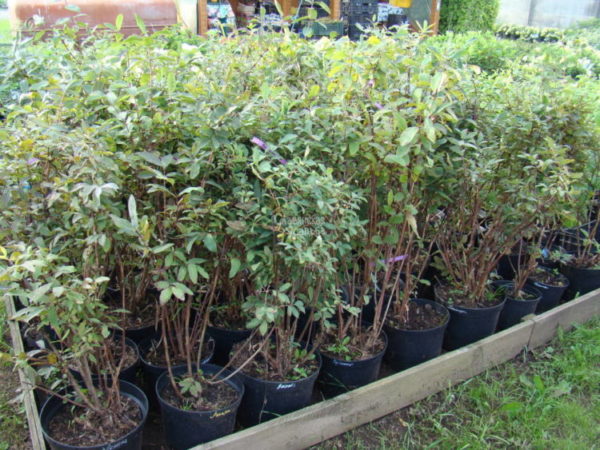 When choosing a honeysuckle planting period, it is advisable to find time in the fall. The culture is unpretentious, seedlings with a good earthen lump take root in the spring, but at this time there is a great risk of miscalculating with deadlines. The plant begins sap flow early, and if you do not have time to open the buds, the honeysuckle will wither.
When choosing a honeysuckle planting period, it is advisable to find time in the fall. The culture is unpretentious, seedlings with a good earthen lump take root in the spring, but at this time there is a great risk of miscalculating with deadlines. The plant begins sap flow early, and if you do not have time to open the buds, the honeysuckle will wither.
It is most convenient to land in September or October, taking into account the particular weather and climate of a particular area.
Choosing a landing place
When choosing a place for shrubs, the following should be considered:
- the crop bears fruit abundantly only in well-lit areas;
- honeysuckle does not tolerate drafts, winds, as fragile branches quickly break;
- likes to grow on fertile slightly acidic soils.
Suitable places for landing are in small lowlands, but without stagnation of water, with protection in the form of farm buildings or fences. Landings are closed from the north, from cold winds.
On soils with high acidity values before the autumn planting of honeysuckle, chalk or slaked lime (100-200 grams per square meter) is applied in about 1-1.5 months. On clay soils, a drainage layer is made in the pit.
Landing pit: preparation
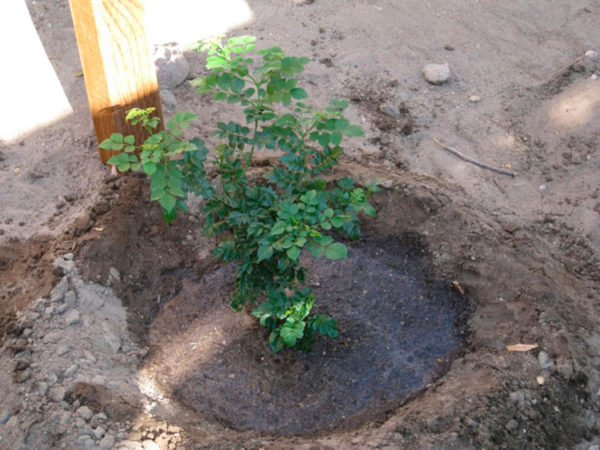 A pit for seedlings is prepared in advance so that the soil has time to settle. In one place, the berry plants with good care grow up to two decades, so you need to take care of filling the soil.
A pit for seedlings is prepared in advance so that the soil has time to settle. In one place, the berry plants with good care grow up to two decades, so you need to take care of filling the soil.
The top layer of fertile land is left, it will be needed to prepare the nutrient mixture. Its composition:
- humus (8-10 kg);
- potassium salt (enough 30-40 grams);
- superphosphate (standard rate of 200 grams).
The components are mixed, added soil and half-filled in the pit. Then cover it from above and leave until the day of planting.
Sizes of the pit: in diameter - 40-50 cm, in depth - up to 30-40 cm.
Landing depth
It is important to plant the honeysuckle in depth. A seedling is carefully placed in the pit so that its neck is at the level of the surface of the earth. Then gently sprinkle the roots with the remaining nutrient mixture, soil. Abundantly watered planting. After some time, the soil will settle, the seedling will drop slightly and its neck will be 4-6 cm below the ground surface. But this is done only on light soils. On heavy soil should not be deepened, as the main roots can be warmed up.
It is advisable to mulch the plantings with peat or humus.
Selection of planting material
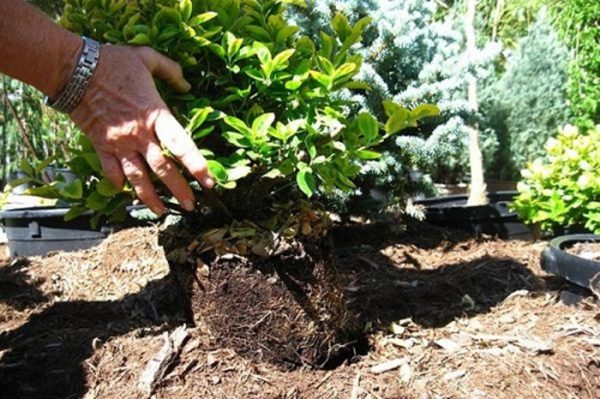 In autumn, a wide selection of honeysuckle seedlings is presented in the nurseries. How to choose planting material:
In autumn, a wide selection of honeysuckle seedlings is presented in the nurseries. How to choose planting material:
- Buy plants with a height of not more than 150 and not less than 25 centimeters. "Giants", like "babies" take root for a long time, bear bad fruit, so it is better not to take them.
- The age of the honeysuckle should be 2-3 years.
- At least three different varieties are selected for one plot. The culture is self-infertile, pollination is required. In this case, it is desirable to find varieties that bloom at the same time.
- They buy healthy, strong plants, without defects on the bark, with whole and dense buds.
- When buying varieties of honeysuckle for planting in the fall, it is preferable to plants in containers or pots, with closed roots.
Seedlings from containers take root faster, are actively growing.
The number of honeysuckle bushes on the site
The culture is cross-pollinated, so the garden should have at least two, or even three or four varieties. If you grow only one variety (albeit several bushes), the honeysuckle will please with abundant flowering, but will not bear fruit.
Do not forget about the flowering time, since when the periods do not coincide, their pollination will not occur, and the berries will not grow. The choice of pollinators is taken seriously, experts believe that the number of berries and their taste depend on this.
Joint landing options
| Main grade | Varieties suitable for pollination |
| Blue spindle | Cinderella, Kamchadalka, Bluebird |
| Nymph | Amphora, Chosen One |
| Cinderella | Amphora, Gerda, Azure |
| Bakcharsky giant | Nymph, Amphora, Pride of Bakchar |
| Siberian | Narymskaya, Tomichka |
| Blue bird | Malvina, Blue Spindle, Cinderella |
Honeysuckle planting pattern
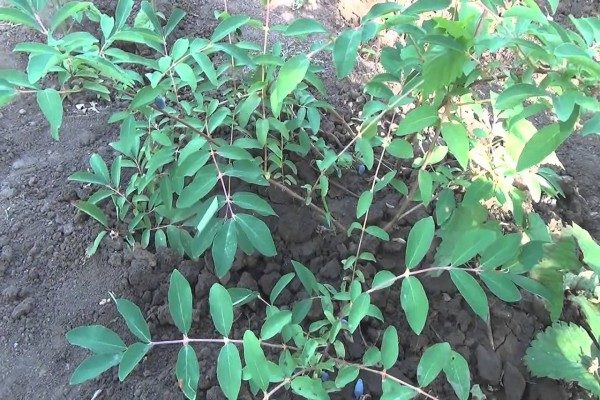 A good harvest is obtained subject to all the rules of agricultural technology, including the distance between the pits when planting honeysuckle in the fall. The branches of the bushes are fragile, with crowded landings they will break. In addition, illumination and ventilation of plants are deteriorating, it is more difficult to pick berries.
A good harvest is obtained subject to all the rules of agricultural technology, including the distance between the pits when planting honeysuckle in the fall. The branches of the bushes are fragile, with crowded landings they will break. In addition, illumination and ventilation of plants are deteriorating, it is more difficult to pick berries.
Therefore, for tall bushes leave a distance of two meters, for low - up to 1.2-1.5 meters. The first group includes varieties:
- Fortune;
- Nymph;
- Volkhov;
- Bakcharsky giant
Undersized varieties:
- Ramenskaya;
- Gzhel late;
- Blue bird
The distance between the aisles is 2-3 meters.
Landing in the regions: features
Wild shrubs from the Siberian taiga served as the basis for breeding breeders of fruitful varieties of healthy berries. In the wild, an unpretentious culture grows in Siberia, the Far East, and Kamchatka. It can be seen on the hillsides, in ravines.
Severe frosts are not afraid of shrubs, but honeysuckle does not tolerate severe drought and heat. You should also beware of sudden warming in the winter, when the bushes can freeze.Such differences are characteristic of the middle lane, so gardeners in this region need to be careful and take care of shelter.
Siberia, Ural
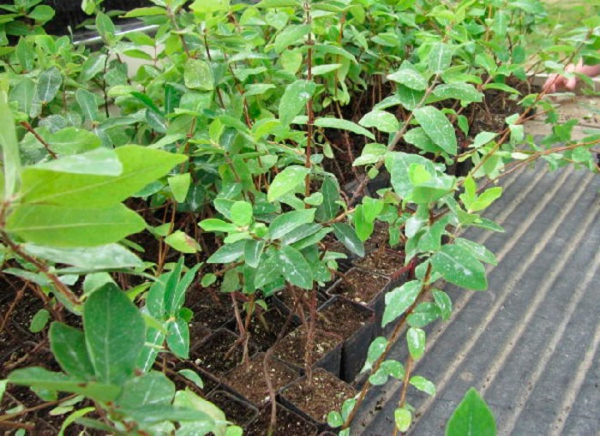 Suitable regions for planting honeysuckle in the spring, because when planting in autumn, immature seedlings often freeze due to early cold weather. Seedlings of three years old with a closed root system are better adapted in the local climate.
Suitable regions for planting honeysuckle in the spring, because when planting in autumn, immature seedlings often freeze due to early cold weather. Seedlings of three years old with a closed root system are better adapted in the local climate.
The landing dates are timed to the beginning of June, when the danger of return frosts passes. Until the fall, the plants get stronger and in the winter will leave already able to withstand severe frosts.
Midland, Moscow Region
The first half of September (before the 15-18th day) is the best time for planting work. Active vegetation has come to an end, honeysuckle is gradually entering the dormant period.
Spring planting is rarely practiced, as return frosts often occur in the region. If the need arose, they choose the time at the end of March, planting a prepared seedling with a large lump of land.
Volga region
Another region for which all the same the best time for planting berries is spring. It is necessary to plant plants before buds open, otherwise the honeysuckle will take root for a long time, and there is a high risk of death of the bushes.
Southern regions
It is problematic to grow a good honeysuckle crop in southern Russia. The climate is unsuitable for crops, yields occur after 1-2 years, the indicators are low. If, nevertheless, there is a desire to try how the culture will grow on the site, then you should look for a shaded place for it and provide abundant regular watering.
Decorative honeysuckle: landing
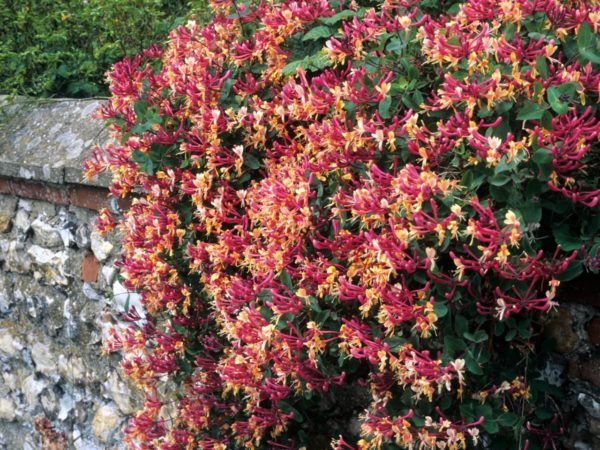 Noting the specifics of planting edible honeysuckle, do not forget about decorative varieties. Usually these are curly vines, the length of which reaches several meters. They are used for vertical landscaping, design in landscape design.
Noting the specifics of planting edible honeysuckle, do not forget about decorative varieties. Usually these are curly vines, the length of which reaches several meters. They are used for vertical landscaping, design in landscape design.
Planting is not much different from planting edible varieties, but in order to quickly obtain shoots, shoots of ornamental plants are often buried in trenches. So from one shoot get several viable bushes.
The group includes many varieties that differ in appearance and distribution area. Plants are unpretentious, frost-resistant, differ from traditional varieties in the shape of berries. They have round and small, red, orange or black.
Among the most famous varieties, honeysuckle stands out with honeysuckle shoots up to almost 5-6 meters in length. It has a long growing period (up to 3 years), high frost resistance. Blooms profusely with bright orange or pink flowers. In sunny places, on supports (fences, arbors) forms green curly walls.
Popular decorative varieties:
- Hekrot;
- Telman;
- Brown
- Seaside;
- Gerald.
Autumn planting is recommended; seedlings are not pruned.
Young planting care
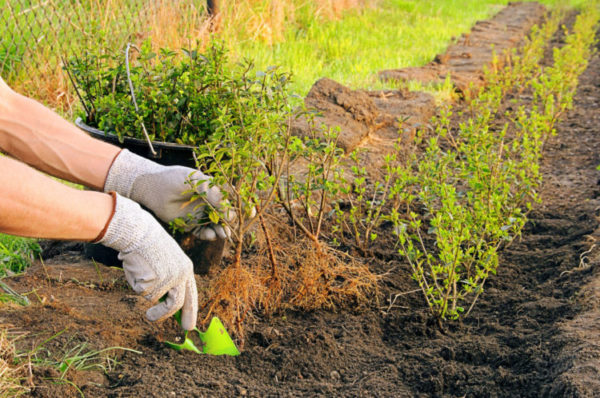 Planting and caring for the berry in the fall will not require much time from the gardener. The main thing is not to miss the deadlines so that young plants take root and successfully survive the winter.
Planting and caring for the berry in the fall will not require much time from the gardener. The main thing is not to miss the deadlines so that young plants take root and successfully survive the winter.
Key events:
- loosening;
- mulching;
- watering.
It is necessary to remove weeds near the bushes, to dig a little soil to the base of the bush. If everything is done correctly, then the first berries are expected in the second year. Bushes enter the peak of fruiting in 5-6 years.
Loosening
Measles of the bush lie in the upper layer of the soil, therefore, the soil is loosened neatly. It is especially important to do this in spring and summer, providing an inflow to the roots of oxygen.
In autumn, the soil around the bushes is carefully dug with a pitchfork. Depth - 12-15 cm. When using mulch (humus, peat, sawdust) the earth can not be loosened.
Watering and feeding
On watering the bushes pay special attention.If the plant does not have enough moisture, then the berries will grow bitter. Irrigation volumes are determined by the state of honeysuckle, weather conditions, type of soil. It is often watered in the heat, spilling the soil well.
For top dressing, complex formulations are used, strictly observing the norms. In the spring they are fertilized with nitrogen-containing compounds, in the autumn it is useful to feed honeysuckle with potassium and phosphorus. The use of organic matter is allowed for about 3-4 years, but fertilizers should be well rotted. Norm - 10 liters per bush.
Circumcision
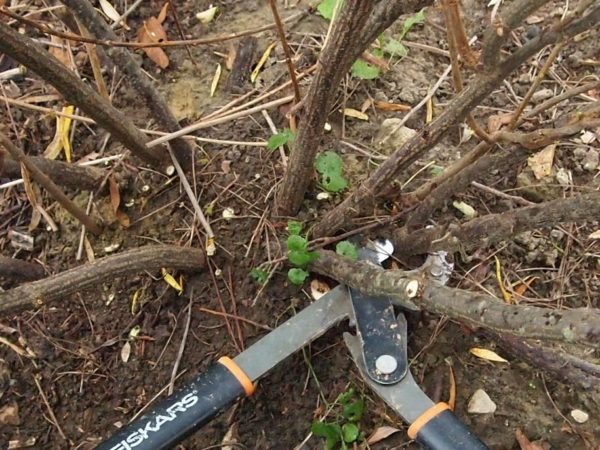 When growing crops, do not forget that in the first 2-3 years the bushes grow slowly. Therefore, it is important to trim the honeysuckle correctly in the fall according to age. Pruning immediately after planting weakens the bush, delays future fruiting.
When growing crops, do not forget that in the first 2-3 years the bushes grow slowly. Therefore, it is important to trim the honeysuckle correctly in the fall according to age. Pruning immediately after planting weakens the bush, delays future fruiting.
Bushes pruning scheme
- If the root system is damaged, the seedling can be cut 1/3 before planting.
- In the spring, old or diseased twigs are removed from the bushes.
- During the growing season, dried and thin branches are removed. The culture is characterized by the presence of numerous shoots with underdeveloped buds. They dry, thicken the plant. They need to be cut.
- From 4 years of age, they carry out forming pruning, removing thick branches in the center of the bush, weak and creeping shoots on the surface of the earth. Be sure to cut the stems with a small increase.
- Bushes that are over 8 years old are rejuvenated every 4-5 years. To do this, cut some trunks, remove excess branches. Optimally, if an adult bush has 4-5 well-developed skeletal branches.
- For old bushes, radical pruning is performed in the fall for rejuvenation. For this, the plant is cut at a height of 30-40 cm from the soil surface. For the formation of a new powerful bush it will take 2-3 seasons.
Be sure to take into account that in the honeysuckle, the kidneys are located at the tips of the shoots. Therefore, global pruning is not allowed, leading to a significant decrease in the yield of bushes. All sections after the procedure are coated with oil paint or garden var. In the fall, after pruning, potash and phosphorus fertilizers are applied to support a weakened bush, and honeysuckle is abundantly watered.
Breeding
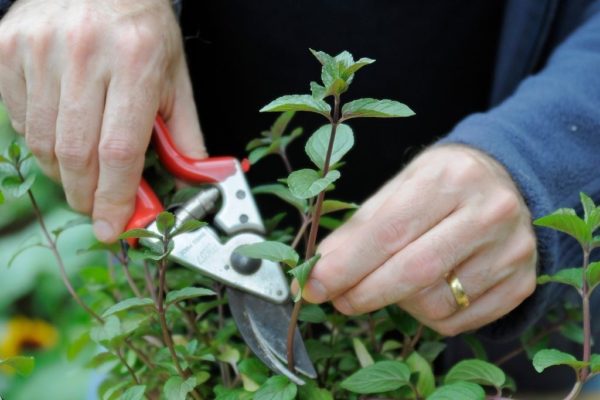 For reproduction, three main methods are used:
For reproduction, three main methods are used:
- division of adult plants;
- cuttings;
- seeds.
Each has its own characteristics, and among the popular ones - cuttings and division of the bush.
Seed way
But let's start with seed propagation - a time-consuming and inefficient method. Used mainly in breeding to create new varieties. The results are different, so amateur gardeners are skeptical of this technology. It is not possible to repeat all the qualities and properties of the mother plant when planted with seeds; almost 1/3 of the honeysuckle loses them.
To obtain seeds, juicy and ripe berries are selected, laid out in the sun for about a couple of hours. Next, honeysuckle is sown on prepared beds of a mini-nursery.
Stages:
- They make 2 cm deep holes, a distance of 10 cm.
- Squeeze the flesh of the berries along with the seeds into the wells.
- Lightly sprinkle with earth and irrigate planting water.
- Cover the bed with a film or covering material.
- The film is regularly raised for ventilation, the ground is sprayed with water.
- When shoots appear, shelter is removed.
Sprouts appear after about 30-40 days. Until the fall, with proper care, the bushes form 3-4 leaves. For the winter, they must be covered with agrofibre, spruce branches from the cold.
In the mini-nursery, honeysuckle has been growing for 2 years. Then strong plants are selected and, together with an earthen lump, transplanted to a permanent place.
In spring crops, they are harvested with seeds in the summer of the previous season, stored in a dry place in winter. In the spring, they are immediately planted in open ground (with the onset of stable heat) or seedlings are first grown and only then - in a constant place in the open air.
Boxes are stuffed with a nutrient mixture:
- river sand;
- humus;
- ash.
Sand and humus are taken in equal proportions, a little ash is added.Between the seeds leave a distance of 1 cm, sown in moist soil. Sprouts appear slowly, grow very hard. They are grown at home until autumn, and taken out to the greenhouse by winter, carefully sheltered and left until spring.
After warm days, the plants open. After, when the bushes become 5-6 cm high, they dive into the garden and grow another season there. Then they are seated at the chosen place.
When propagated by seeds, honeysuckle usually gives the first berries no earlier than the fifth year
Propagation by cuttings
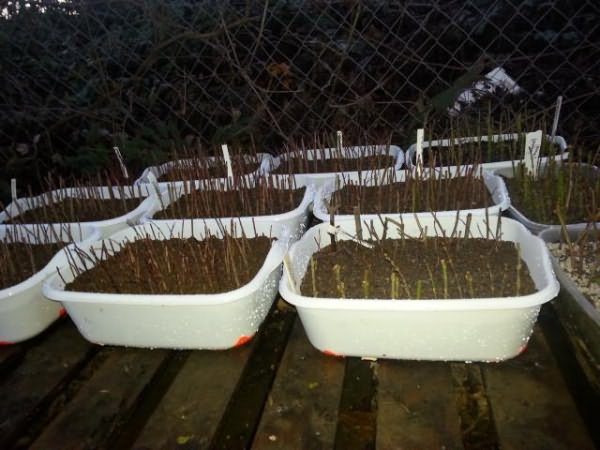 The most popular breeding options are lignified or green cuttings.
The most popular breeding options are lignified or green cuttings.
Lignified cuttings
At the end of autumn, cuttings are cut, planted in containers filled with peat and sand. Regularly watered, slightly loosen the soil. Such seedlings are ready for planting next fall.
If you cut the cuttings for the winter under the snow, then they are planted in the spring. It is recommended to place the honeysuckle obliquely in the holes, leaving only one kidney on top.
In the garden, young bushes grow for 2-3 years, then they are dug up and planted in selected places on the site.
Green cuttings
Honeysuckle can be propagated with green cuttings. To do this, cut shoots of the current year (10 cm each), plant them in a greenhouse.
Cutting time - the appearance of green berries on adult bushes. In the greenhouse, cuttings quickly give roots (after about 15-18 days). Look after until the fall, then carefully cover for the winter. In spring, plants are planted in a permanent place.
Layering
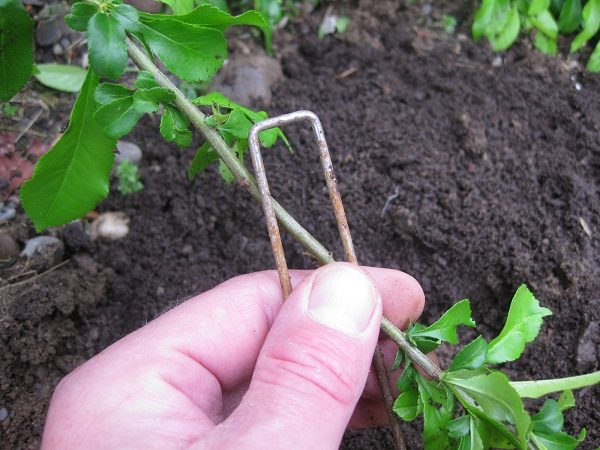 No less popular is the method of reproduction using layering from adult bushes.
No less popular is the method of reproduction using layering from adult bushes.
- The lowest strong branches are bent to the ground.
- Dig a small groove (its depth on light soils is 5 cm, on heavy soils - 2-3 cm). Using a staple or a wooden fork, pin the shoot to the ground, lay in a groove and lightly sprinkle with soil.
- After some time, layering will give roots.
Separate it from the mother bush the next year.
Bush division
Bushes that have reached the age of 8-9 years can be divided. At the same time, each delenka leaves:
- well-developed roots (20-30 cm each);
- 2-3 branches;
- 2-3 stems.
For separation, use a pitchfork and a saw. Usually they divide the bushes in the spring, before the buds open. Parts of the bush are planted in a prepared place, watered. After 30-40 days, the seedlings give roots.
Shelter for the winter
Unpretentious honeysuckle is not afraid of frost, but if you do not take care of preparing for the winter, the bushes may freeze during the thaw.
Most edible varieties of culture do not need shelter. The culture easily tolerates temperatures below minus 50ºC, flower buds and roots do not suffer. The danger is sudden thaws in winter, when frost comes sharply after warm days.
Curly varieties of decorative honeysuckle protect from cold weather, removing from supports and covering with spruce branches or agrofibre. In this form, even the most severe frosts are not afraid of bushes.
Honeysuckle transplant to a new place
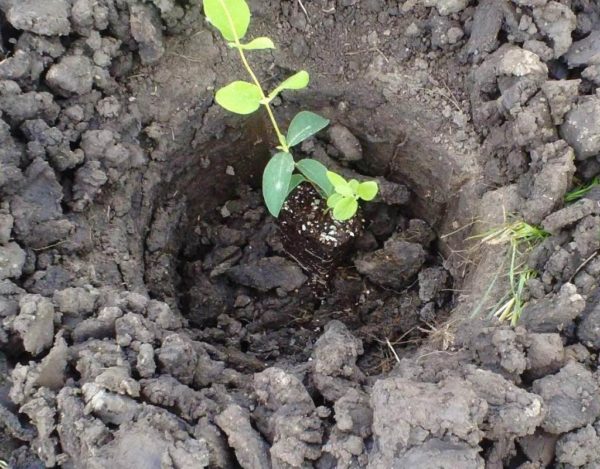 It so happens that you want to transplant the bush to another place. The reasons are different:
It so happens that you want to transplant the bush to another place. The reasons are different:
- redevelopment of the site;
- initially unsuccessful choice of place;
- the desire of the new owners of the garden.
It is recommended to transplant only plants under the age of five, as honeysuckle is older than poorly engraftment and often dies.
When to transplant honeysuckle
A honeysuckle transplant is advisable in the fall, in the middle lane these are the dates - September and before half of October. It is not worth carrying out work in the spring, since sap flow begins early in the bushes, and the plant will lose a lot of energy during transplantation.
 You may be interested in:
You may be interested in:Landing pit preparation
Prepare a place for landing in advance:
- dig holes (diameter not less than 70-80 cm);
- stack drainage on the bottom (fragments of brick, pebbles, expanded clay);
- humus is added (up to 15 kg, 200-300 grams of superphosphate, a liter of ash).
In adult bushes, the root system is well developed, so there should be enough space in the pit.
Preparing a bush for a transplant
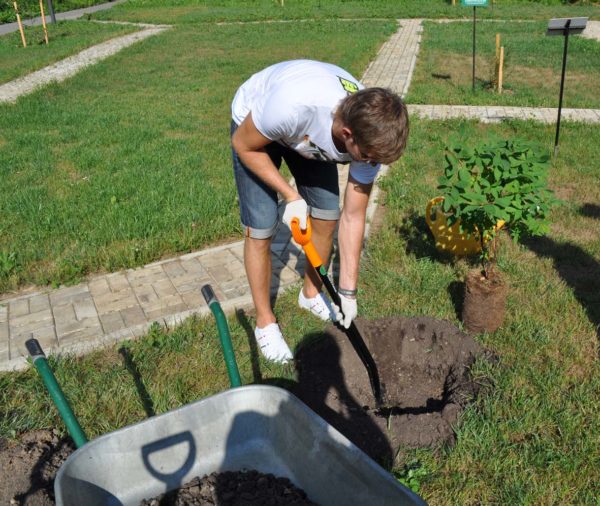 On the bush, dry or damaged branches are carefully cut, shoots are shortened. The best plant height is up to half a meter. Honeysuckle dug in a circle, trying not to damage the roots. It is necessary to transplant with a lump of earth, so adaptation will pass faster.
On the bush, dry or damaged branches are carefully cut, shoots are shortened. The best plant height is up to half a meter. Honeysuckle dug in a circle, trying not to damage the roots. It is necessary to transplant with a lump of earth, so adaptation will pass faster.
Before the plant will be taken out, the ground is carefully shed. The dug out honeysuckle is laid on burlap or tarpaulin, the excess roots are carefully cut. In the pit, the bush is placed strictly vertically, laying carefully the roots and not deepening the root neck. They fill it with soil, irrigate it well, mulch the bush.
Transplanted bush care
Further care standard:
- watering;
- top dressing.
It is especially important to control the soil moisture, preventing drying out. They feed the bush in spring, using complex fertilizer compositions.
Storage of seedlings before planting in the ground
How to save seedlings if immediately planting them in a permanent place is impossible? Take into account:
- condition of bushes;
- time of year (spring or autumn);
- own capabilities.
In early spring, if the buds are still sleeping, but the weather does not allow planting, the plants are cleaned in the refrigerator. If the plant comes to life, then first they plant it in a prepared container at home, and only then, when favorable days arrive, they plant it on the street.
In autumn, seedlings must be planted, and if not possible, then dig in the garden. Planting such a honeysuckle in a pot for growing a house in winter is not worth it, since there is a high risk of losing a plant.
Reviews
Peter, Moscow Region
The first time I planted honeysuckle 10 years ago, in the spring. And the bushes died due to the drought. Then he began to plant it only in the fall, grow by leaps and bounds! There are no small berries, bear fruit abundantly, quickly take root, A pair of bushes grows in partial shade, and then bear fruit well. That's what it means - the right landing time.
Rose, Penza
My honeysuckle is growing in a small shadow, and for five years I realized that this is exactly what culture needs. The soil is still important - light, loose, constantly slightly moist (but without moisture congestion).
Planted all the seedlings in the fall, perfectly took root (I have Bakchar varieties). Everything is growing slowly, but yields are excellent.
Conclusion
Gardeners unfamiliar with honeysuckle should look closely at this healthy berry. Planting bushes in the fall, and providing proper care, after a few years you can get a good harvest, and a wonderful bonus will be the magnificent decorative qualities of the culture.

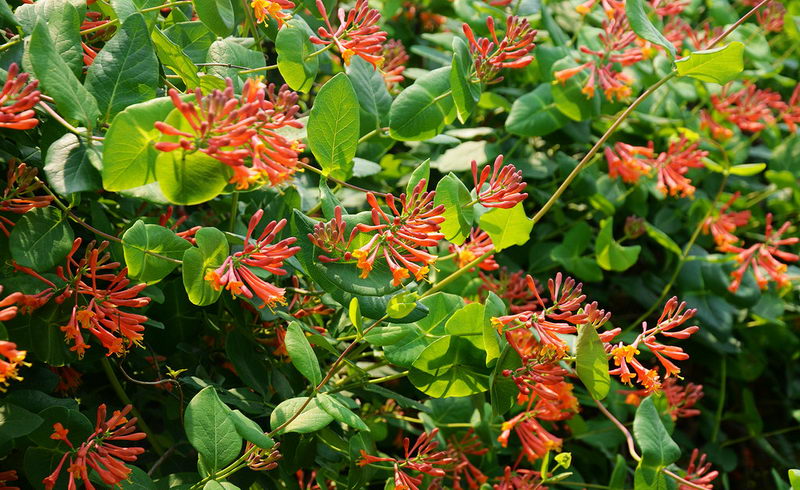
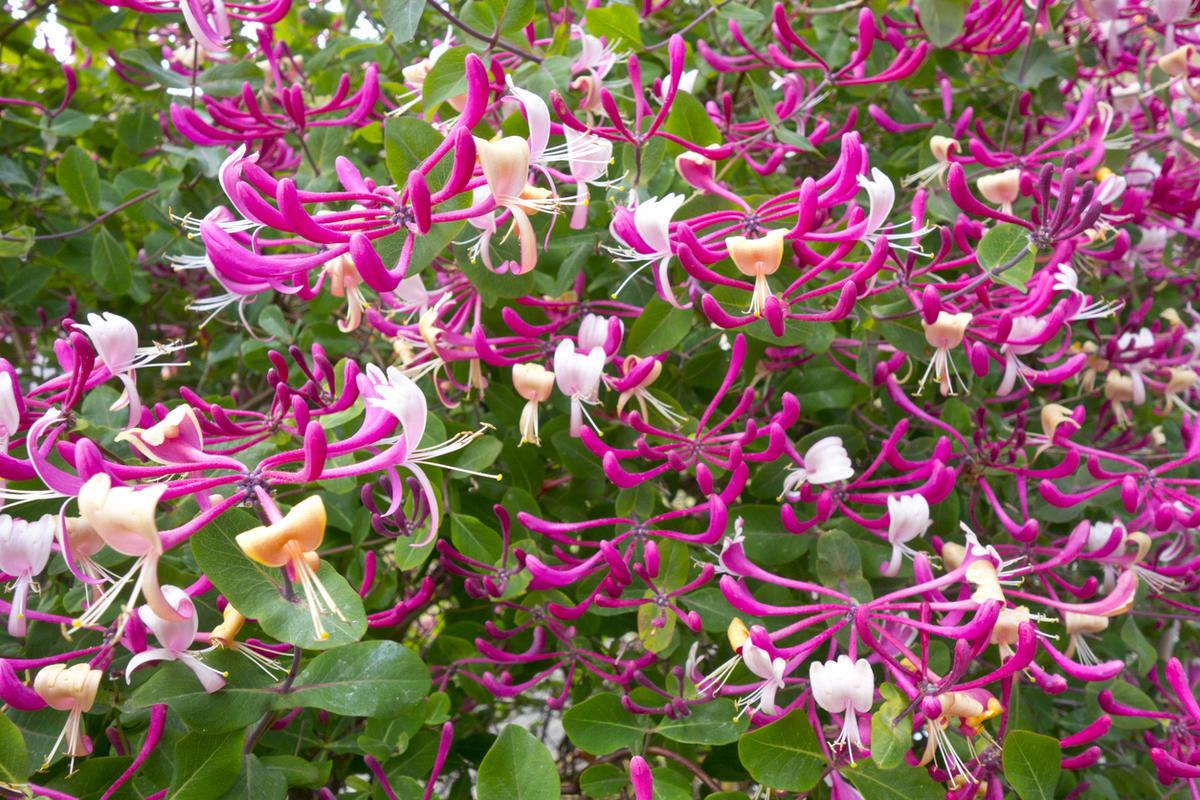
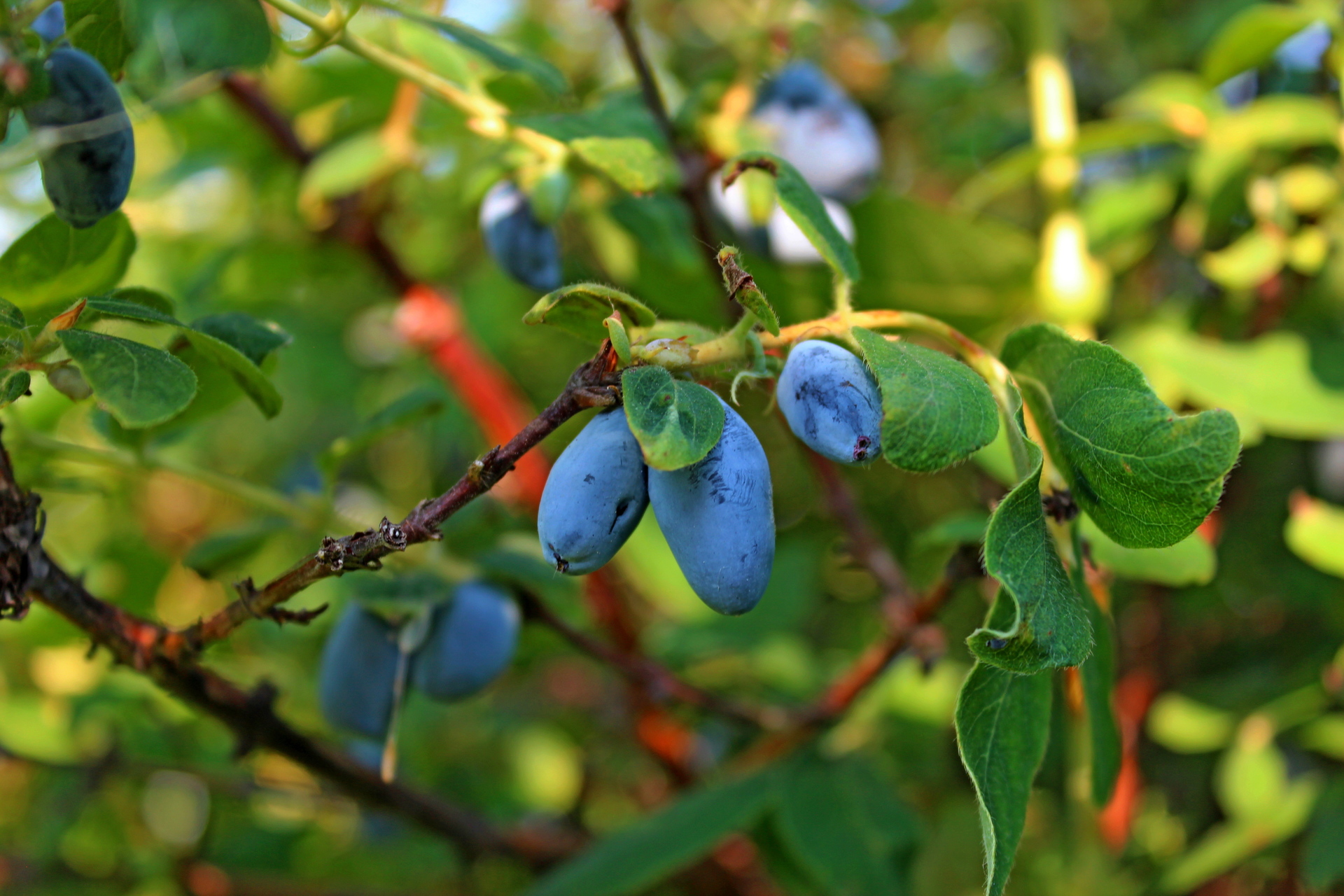
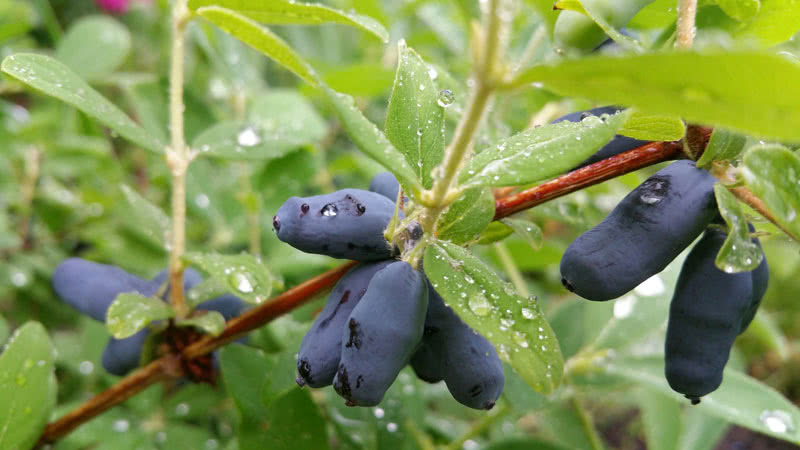 Edible honeysuckle: planting and care, breeding methods, diseases
Edible honeysuckle: planting and care, breeding methods, diseases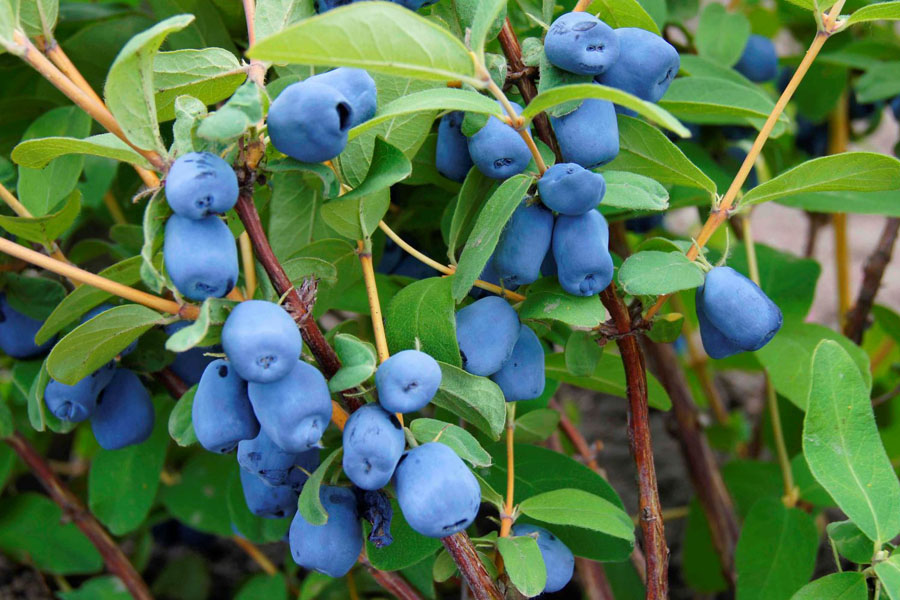 Honeysuckle pruning: when and how to do it correctly, features, patterns
Honeysuckle pruning: when and how to do it correctly, features, patterns Honeysuckle in the fall: planting and care, transplanting, breeding, shelter for the winter
Honeysuckle in the fall: planting and care, transplanting, breeding, shelter for the winter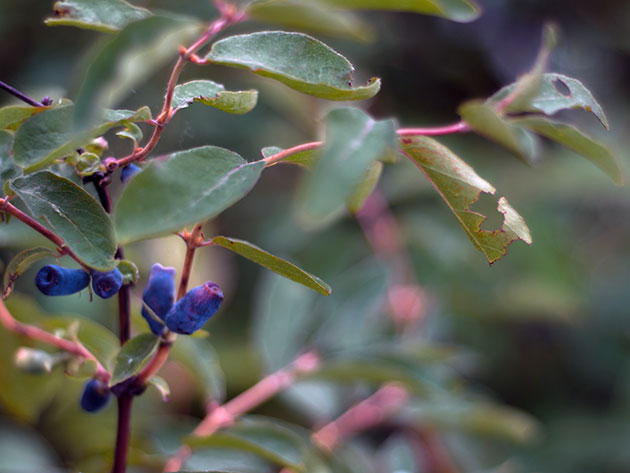 Honeysuckle disease treatment
Honeysuckle disease treatment